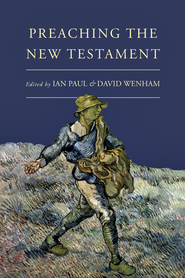 For those who have the privilege and responsibility to preach the Bible week in and week out, the burden of speaking God’s Word to God’s people can be a daunting task. While in my current vocation I don’t preach ever week, I have many good friends that do and I know the blessed struggle preaching is.
For those who have the privilege and responsibility to preach the Bible week in and week out, the burden of speaking God’s Word to God’s people can be a daunting task. While in my current vocation I don’t preach ever week, I have many good friends that do and I know the blessed struggle preaching is.
It has been said that a good preacher is able to both exegete the text of Scripture and also his or her congregation. Preaching is not presenting exegesis to people. As Jonathan Edwards insisted, the preacher needs to bring both light and heat: light for the mind and heat for the heart. It is not surprising then too to hear John Piper challenge preachers to preach in a way that kindles desire in God’s people to love God more than they love anything and desire to please God more than they desire to please anyone.
That’s the kind of preaching I love to sit under, preaching that is passionate with an uncommon depth of insight borne from personal engagement with the text. My personal taste in preaching is for less pragmatism and for more thoughtful reflection. Don’t just tell me what to do–because let’s be honest, that ends up being not much more than spiritual practice shaped by someone’s individual spiritual experience; rather inspire me to do through insightful explanation of Scripture and examples from everyday life.
In a new book, Preaching the New Testament, the editors, Ian Paul and David Wenham, bring together a cadre of New Testament scholar/preachers who reflect on preaching elements of the New Testament. The book is the product of the 2011 meeting of the New Testament Group of the Tyndale Fellowship based in the UK. So it is not surprising that most of the contributors are “on the other side of the pond”.
Preaching the New Testament offers guidance on preaching the Gospels generally as well as specific elements within them, such as the parables, miracles and the Sermon on the Mount. There are also chapters on preaching Paul’s corpus and the General Epistles and Revelation. In addition, there are chapters of a more thematic nature. Peter Oakes, for example, discusses how archaeology and history can help preaching the New Testament. The list of contributors has both senior as well as younger scholar/pastors. This surely provides a good mix of tradition and innovation. The essential nature of the guidance offered in this book is methodological, how one approaches different parts of the New Testament in view of preaching the text.
This book could be used as a tool to a pastor when preparing sermons. I can envisage a pastor having this near to hand when planning a sermon series. Reading the relevant chapter as he or she prepares the series. I could also see the book being used in a classroom for a class that is moving students from exegesis to exposition.















